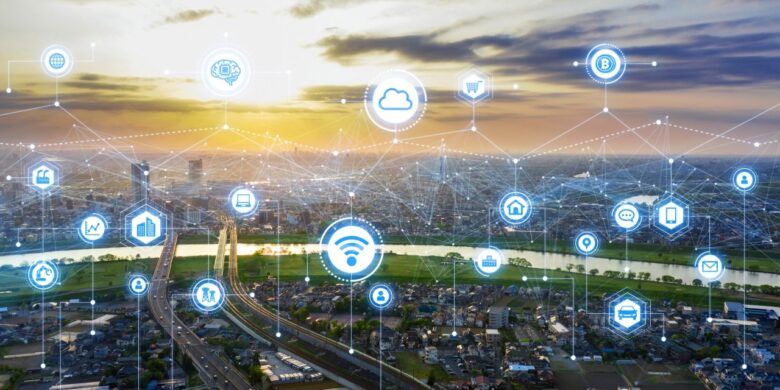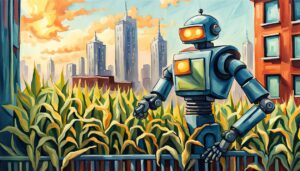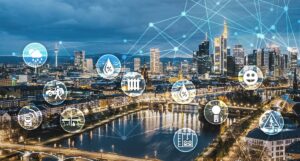The Internet of Things (IoT) is changing every aspect of daily life, and its impact on urban infrastructure is particularly revolutionary. IoT technology is helping urban areas become more connected, responsive, and efficient by integrating them into municipal systems. Many of the issues facing modern cities, including congestion, energy management, and public safety, can be partially addressed through such integration. The Internet of Things plays a wide and diverse role in today’s urban infrastructure, influencing city operations and improving the quality of life for residents.
1. Harnessing Real-Time Data to Transform City Management
IoT is key to transforming city management through real-time data provided by connected sensors and gadgets. IoT sensors are now present in much of the infrastructure of modern cities, including environmental monitoring stations, trash bins, and traffic lights. These sensors continuously collect and transmit data, which is then analyzed to guide decisions and maximize municipal operations. For example, real-time traffic data from IoT sensors can enable traffic management systems to change signal timing to reduce congestion and increase traffic flow. Similarly, real-time environmental data can help local managers monitor air quality and implement policies to reduce pollution. With real-time data, cities can improve their management capabilities and better respond to changing metropolitan environments.
2: Enhance Public Safety and Security
Integrating IoT technology is improving urban public safety and security. IoT-enabled cameras and sensors on smart surveillance systems provide comprehensive monitoring of public spaces. These technologies can track public movements, identify suspicious behavior, and provide real-time alerts to law enforcement agencies. For example, IoT cameras with advanced analytics can detect unusual behavior or potential hazards, allowing for a quick response. IoT-based emergency response systems can also streamline communication between first responders and emergency services personnel, improving response times and coordination in difficult situations. IoT technology helps create safer urban environments by improving surveillance and emergency management.
3. Improve Energy Consumption
Another area where IoT is having a major impact on today’s urban infrastructure is energy management. Smart grids are integrating IoT technology to ensure more reliable and efficient energy delivery. Real-time monitoring of energy consumption, fault detection, and energy flow management IoT sensor monitoring enables better load balancing, reduces energy waste, and improves the overall efficiency of the energy system through this data-driven strategy. In addition, IoT-enabled smart meters can provide homeowners with a complete picture of their energy consumption, allowing them to make informed consumption choices. IoT technology helps create more affordable and greener urban energy systems by optimally managing energy consumption.
4. Empower Waste Management Technology
Another important area where IoT is significantly changing is waste management. IoT sensors in smart waste management systems track bin fill levels and help maximize collection routes. These systems ensure efficient waste collection by providing real-time data on waste levels, thereby reducing the need for manual inspections. IoT waste management also helps reduce the environmental impact of waste collection by minimizing fuel consumption and thereby reducing greenhouse gas emissions. Additionally, information gathered from smart waste systems can be examined to identify trends in waste generation and guide policies aimed at reducing waste levels and supporting recycling.
5. Improve Transportation Infrastructure
Improving transportation systems in today’s cities relies heavily on IoT technology. Using IoT sensors and devices, intelligent transportation systems can monitor and control many aspects of urban transportation. For example, IoT-enabled traffic lights can adapt to real-time traffic conditions, improving traffic flow and reducing congestion. IoT technology enables public transportation systems to provide real-time schedules and vehicle location updates, making transportation options more reliable and convenient. IoT-based parking management systems also enable vehicles to find accessible parking spaces more quickly, saving time searching for parking spaces and reducing traffic congestion.
6. Supporting Intelligent Building Management
Another area where IoT technology is significantly changing is smart building management. IoT-enabled building systems can monitor and manage many building activities, including heating, ventilation, air conditioning (HVAC), lighting, and security, in real-time. These systems maximize energy consumption, improve occupant comfort, and improve the overall efficiency of the building by leveraging data from IoT devices. For example, smart HVAC systems vary heating and cooling based on usage patterns, reducing energy consumption and bills. Energy efficiency is further improved by an IoT-based lighting system that can vary brightness levels based on occupancy and natural light.
7. Increase Community Participation
IoT technology also increases community involvement by providing people with interactive services and real-time access to knowledge. Smart city applications and platforms provide citizens with information on many aspects of city life, including traffic conditions, public transport schedules, and environmental monitoring, including data from IoT-enabled systems, and also enable citizens to help local management and delivery of infrastructure and services. For example, smart city applications can keep their neighborhoods in better shape by allowing citizens to report problems such as broken lights or potholes. IoT technology helps people and local authorities work together by increasing community involvement.
Conclusion
The Internet of Things plays a significant and widespread role in today’s urban infrastructure, changing the way cities function and improving the quality of life of their residents. By integrating IoT technology into many aspects of city management, public safety, energy management, waste management, transportation, building management, and urban planning, cities have the potential to become more efficient, responsive, and connected. IoT enables better security, efficient resource management, improved mobility, and greater community participation, among other benefits. As cities continue to adopt IoT technologies, more sustainable and comfortable urban environments will become possible, as they offer enormous opportunities for innovation and development of urban infrastructure.
FAQs
1. What is the Internet of Things (IoT)?
The Internet of Things (IoT) is an online network of interconnected sensors and devices used to transmit and share data. These gadgets can range from common items such as mobile phones and smart devices to more complex systems such as traffic control sensors and environmental monitoring equipment.
2. In what ways can the Internet of Things advance urban development?
IoT is improving city management by providing real-time data through connected sensors and gadgets. Municipalities use this information to make informed decisions about traffic management, energy consumption, waste collection, and other aspects of city operations, resulting in more efficient and responsive city management.
3. How can IoT improve public safety?
IoT is improving public safety by using smart surveillance systems with IoT-enabled cameras and sensors to monitor public spaces. These devices provide law enforcement agencies with real-time alerts, detect unusual behavior, and identify potential hazards. IoT devices can also support emergency response by enabling faster communication and better coordination in difficult situations.
4. In what ways can IoT help cities manage energy?
IoT helps manage energy by enabling smart grids to instantly monitor and control energy distribution. By tracking energy consumption, detecting issues, and ensuring optimal power flow, IoT sensors help reduce energy waste and increase efficiency. In addition, smart meters provide comprehensive information about individual energy consumption, allowing homeowners to make informed decisions about their energy consumption.
5. How is IoT changing waste management?
IoT is impacting waste management through sensors that track bin levels and streamline collection routes. This reduces fuel consumption, greenhouse gas emissions, and the need for manual inspections. Data from smart waste systems can also inform recycling and waste reduction policies by identifying trends in waste generation.




